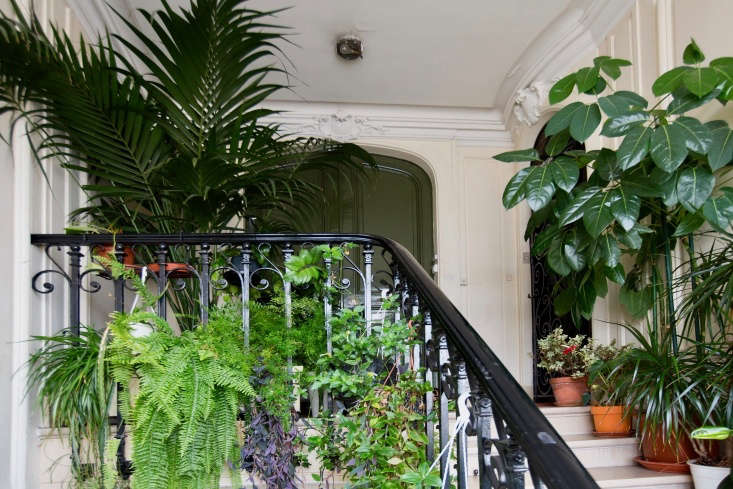One day last summer photographer Mimi Giboin just happened to be in Paris at the right time to capture our friend Tom de Fleurs‘s tiny courtyard garden, looking its summer best, on Rue Bichat. At the end of the day, as Mimi was packing up her camera, Tom asked her if she wanted to see one of his friend’s unusually enchanting indoor gardens nearby, with potted plants along a staircase and landing outside the entrance of a grand Parisian flat.
The instant that Mimi saw the unusual collection of houseplants in the apartment building on Rue Bichat, she unpacked her camera again—to capture the unexpected mise-en-scène of greenery against a formal beaux arts backdrop. Here are eight ideas you can steal from a grand Parisian escalier for your own installation.
Photography by Mimi Giboin for Gardenista.
Riding the Rails

Here ferns and other cascading plants behave just as they would if mounted on a vertical wall.
Entanglements

For more of our favorite vines, see our curated design guides to Vines & Climbers 101 and to Houseplants 101, where we’ve covered vining Philodendron 101: A Guide to Planting, Care & Design.
Winding Path

Ideally, potted plants will look luxurious without blocking egress. With a profusion of foliage, it doesn’t matter if you leave the plants in their nursery pots.
Low-Maintenance Plants

A ZZ plant’s silhouette is a shapely fountain of glossy green tapering wands. A tropical foliage plant native to Africa, Zamioculcas zamiifolia will thrive as a houseplant with baseline care: indirect light, moderate temperatures, and not too much water are key.
Lacy Flowers


Casual Formality

Use plants to soften architectural details.
Heightened Perspective

Play around with heights, textures, and shapes when you group container plants together.
Privacy Screen

With its purple leaves, a Tradescantia pallida vine, shown at center, is a dramatic accent plant and looks especially good against the backdrop of glossy black-painted doors. Shown at left is a spider plant (Chlorophytum comosum) with clusters of flowers that bloom along its long, drooping stems. Placed between the two, a sword fern (Nephrolepis exaltata) explodes exuberantly.
See more ideas to steal from our favorite European gardens (indoors and out):
- How to Garden Like a Frenchwoman: 10 Ideas to Steal from a Paris Balcony
- 10 Garden Ideas to Steal from Provence
- La Dolce Vita: 10 Garden Ideas to Steal from Italy
- How to Garden Like a Frenchman: 10 Ideas to Steal from a Parisian Courtyard
- Paradise Found: Designer Dan Pearson’s Modern Garden for a Medieval Castle
Finally, get more ideas on how to plant, grow, and care for various houseplants with our Houseplants: A Field Guide.









Have a Question or Comment About This Post?
Join the conversation